2018 NISSAN NV PASSENGER VAN tires
[x] Cancel search: tiresPage 371 of 426

Engine coolant*:Replace coolant at the
specified interval. When adding or replac-
ing coolant, be sure to use only Genuine
NISSAN Long Life Antifreeze/Coolant (blue)
or equivalent with the proper mixture. (For
additional information on the proper mix-
ture for your area, refer to “Engine cooling
system” in the “Do-it-yourself ” section of
this manual.)
NOTE:
Mixing any other type of coolant or the
use of non-distilled water may reduce
the recommended service interval of the
coolant.
Engine oil and oil filter: Replace engine oil
and oil filter at the specified intervals. For
recommended oil grade and viscosity refer
to “Recommended fluids/lubricants and
capacities” in the “Technical and consumer
information” section of this manual.
Evaporative emissions control vapor
lines*: Check vapor lines for leaks or loose-
ness. Tighten connections or replace parts
as necessary.
Fuel lines*: Check the fuel hoses, piping
and connections for leaks, looseness, or
deterioration. Tighten connections or re-
place parts as necessary. Spark plugs:
Replace at specified intervals.
Install new plugs of the same type as origi-
nally equipped.
CHASSIS AND BODY
MAINTENANCE:
Brake lines and cables: Visually inspect for
proper installation. Check for chafing,
cracks, deterioration, and signs of leaking.
Replace any deteriorated or damaged
parts immediately.
Brake pads and rotors: Check for wear,
deterioration and fluid leaks. Replace any
deteriorated or damaged parts immedi-
ately.
Exhaust system: Visually inspect the ex-
haust pipes, muffler and hangers for leaks,
cracks, deterioration, and damage. Tighten
connections or replace parts as necessary.
In-cabin microfilter (if so equipped): Re-
place at specified intervals. When driving
for prolonged periods in dusty conditions,
replace the filter more frequently
Steering gear and linkage, axle and sus-
pension parts, drive shaf t boots: Check
for damage, looseness, and leakage of oil
or grease. Under severe driving conditions,
inspect more frequently. Tire rotation:
Tires should be rotated every
5,000 miles (8,000 km) according to the in-
structions under “Explanation of general
maintenance items” in this section. When
rotating tires, check for damage and un-
even wear. Replace if necessary.
Transmission fluid/oil, differential oil: Vi-
sually inspect for signs of leakage at speci-
fied intervals.
9-6Maintenance and schedules
Page 382 of 426
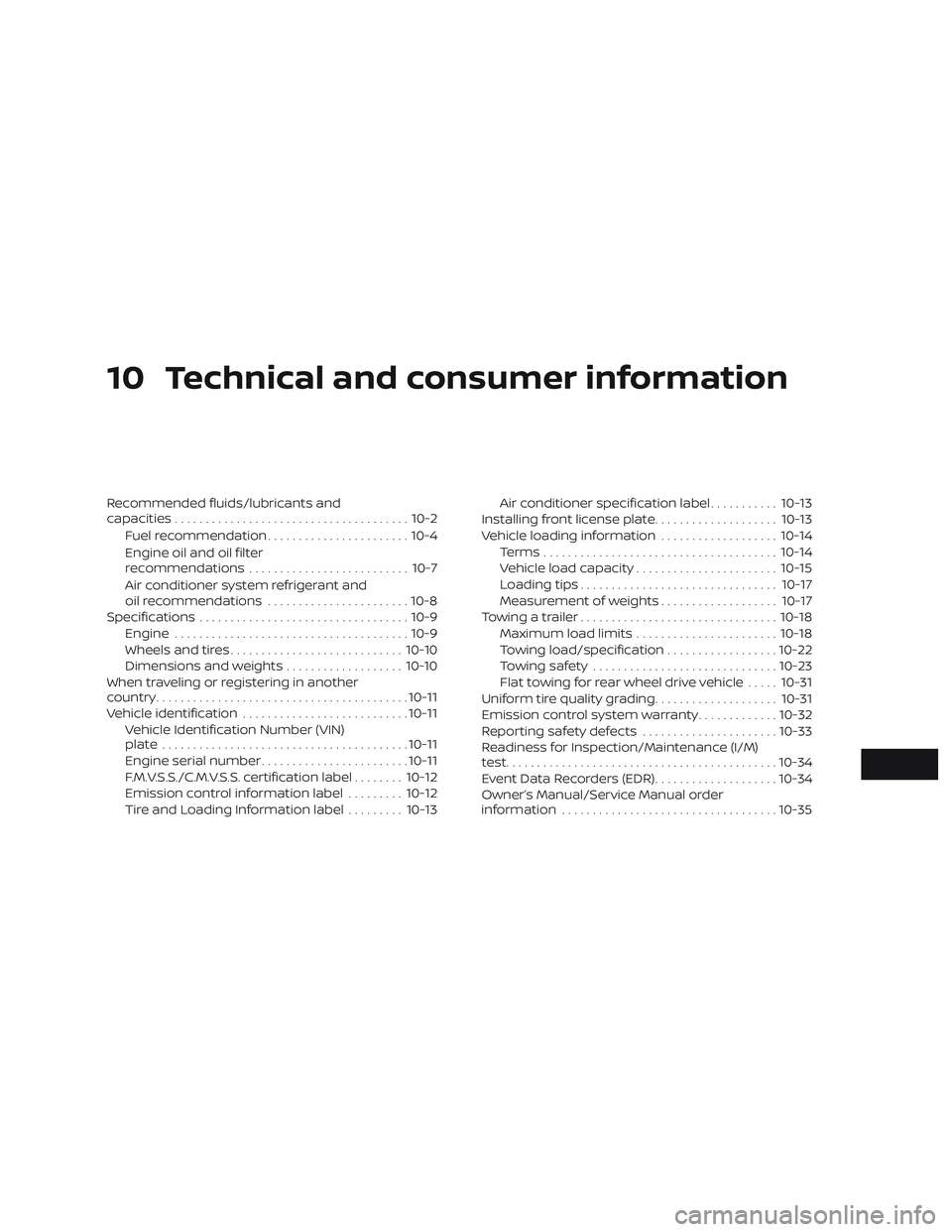
10 Technical and consumer information
Recommended fluids/lubricants and
capacities...................................... 10-2
Fuel recommendation ....................... 10-4
Engine oil and oil filter
recommendations .......................... 10-7
Air conditioner system refrigerant and
oil recommendations .......................10-8
Specifications .................................. 10-9
Engine ...................................... 10-9
Wheels and tires ............................ 10-10
Dimensions and weights ...................10-10
When traveling or registering in another
country ......................................... 10-11
Vehicle identification ........................... 10-11
Vehicle Identification Number (VIN)
plate ........................................ 10-11
Engine serial number ........................ 10-11
F.M.V.S.S./C.M.V.S.S. certification label ........10-12
Emission control information label .........10-12
Tire and Loading Information label .........10-13 Air conditioner specification label
...........10-13
Installing front license plate ....................10-13
Vehicle loading information ...................10-14
Terms ...................................... 10-14
Vehicle load capacity ....................... 10-15
Loading tips ................................ 10-17
Measurement of weights ...................10-17
Towing a trailer ................................ 10-18
Maximum load limits ....................... 10-18
Towing load/specification ..................10-22
Towing safety .............................. 10-23
Flat towing for rear wheel drive vehicle .....10-31
Uniform tire quality grading ....................10-31
Emission control system warranty .............10-32
Reporting safety defects ......................10-33
Readiness for Inspection/Maintenance (I/M)
test ............................................ 10-34
Event Data Recorders (EDR) ....................10-34
Owner
’s Manual/Service Manual order
information ................................... 10-35
Page 391 of 426
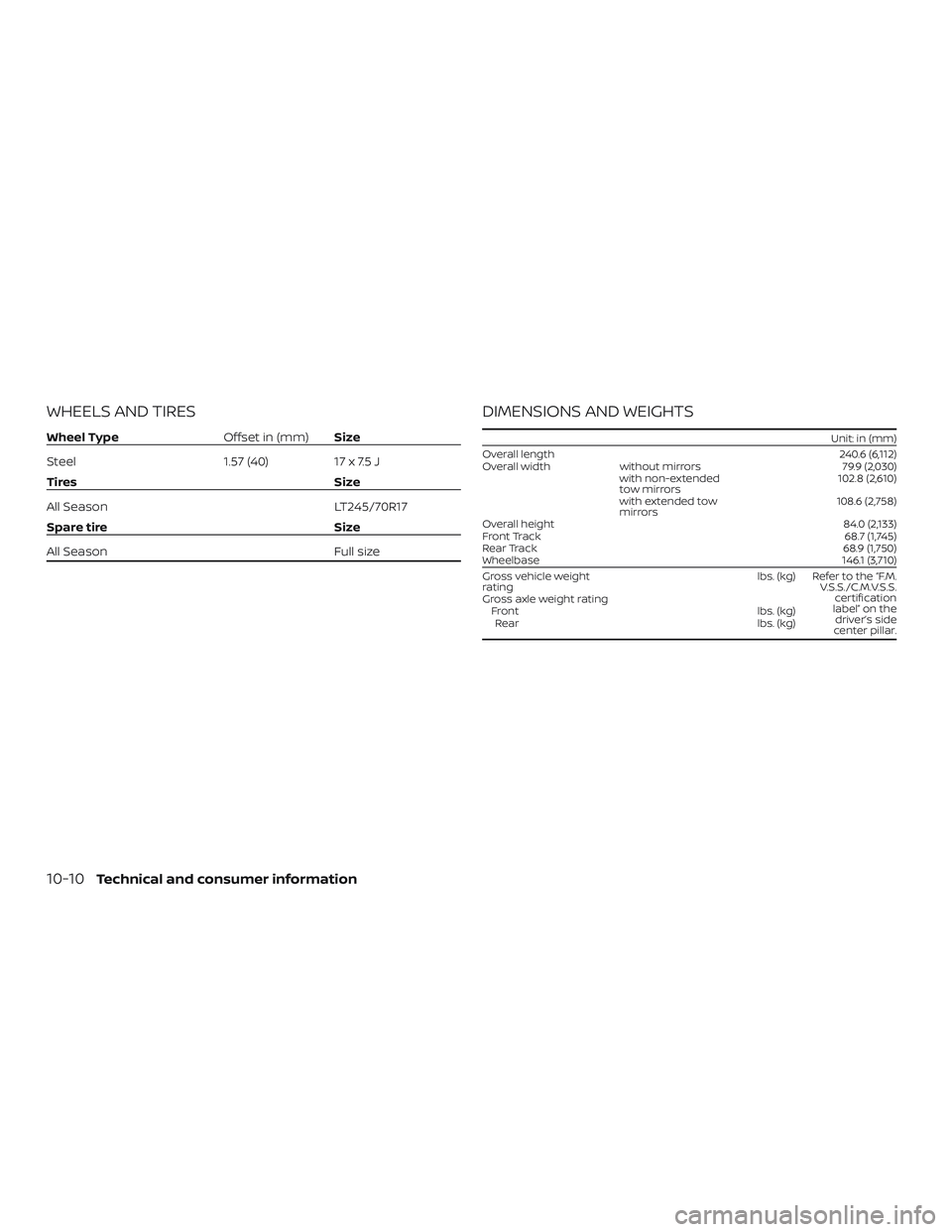
WHEELS AND TIRES
Wheel TypeOffset in (mm)Size
Steel 1.57 (40)17 x 7.5 J
Tires Size
All Season LT245/70R17
Spare tire Size
All Season Full size
DIMENSIONS AND WEIGHTS
Unit: in (mm)
Overall length 240.6 (6,112)
Overall width without mirrors 79.9 (2,030) with non-extended
tow mirrors 102.8 (2,610)
with extended tow
mirrors 108.6 (2,758)
Overall height 84.0 (2,133)
Front Track 68.7 (1,745)
Rear Track 68.9 (1,750)
Wheelbase 146.1 (3,710)
Gross vehicle weight
rating lbs. (kg) Refer to the “F.M.
V.S.S./C.M.V.S.S.certification
label” on the driver’s side
center pillar.
Gross axle weight rating
Front lbs. (kg)
Rear lbs. (kg)
10-10Technical and consumer information
Page 398 of 426
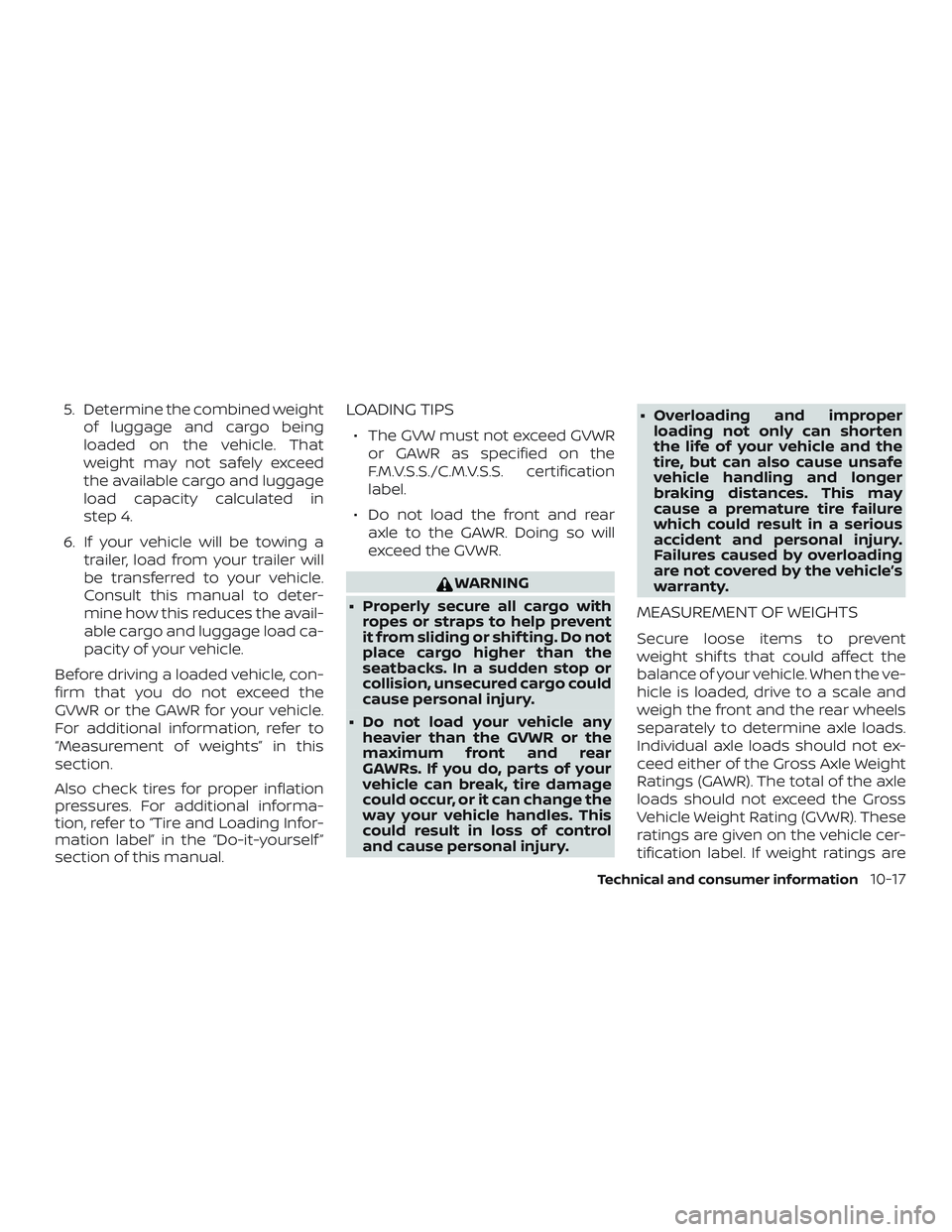
5. Determine the combined weightof luggage and cargo being
loaded on the vehicle. That
weight may not safely exceed
the available cargo and luggage
load capacity calculated in
step 4.
6. If your vehicle will be towing a trailer, load from your trailer will
be transferred to your vehicle.
Consult this manual to deter-
mine how this reduces the avail-
able cargo and luggage load ca-
pacity of your vehicle.
Before driving a loaded vehicle, con-
firm that you do not exceed the
GVWR or the GAWR for your vehicle.
For additional information, refer to
“Measurement of weights” in this
section.
Also check tires for proper inflation
pressures. For additional informa-
tion, refer to “Tire and Loading Infor-
mation label” in the “Do-it-yourself ”
section of this manual.LOADING TIPS
∙ The GVW must not exceed GVWR or GAWR as specified on the
F.M.V.S.S./C.M.V.S.S. certification
label.
∙ Do not load the front and rear axle to the GAWR. Doing so will
exceed the GVWR.
WARNING
∙ Properly secure all cargo with ropes or straps to help prevent
it from sliding or shif ting. Do not
place cargo higher than the
seatbacks. In a sudden stop or
collision, unsecured cargo could
cause personal injury.
∙ Do not load your vehicle any heavier than the GVWR or the
maximum front and rear
GAWRs. If you do, parts of your
vehicle can break, tire damage
could occur, or it can change the
way your vehicle handles. This
could result in loss of control
and cause personal injury. ∙ Overloading and improper
loading not only can shorten
the life of your vehicle and the
tire, but can also cause unsafe
vehicle handling and longer
braking distances. This may
cause a premature tire failure
which could result in a serious
accident and personal injury.
Failures caused by overloading
are not covered by the vehicle’s
warranty.
MEASUREMENT OF WEIGHTS
Secure loose items to prevent
weight shif ts that could affect the
balance of your vehicle. When the ve-
hicle is loaded, drive to a scale and
weigh the front and the rear wheels
separately to determine axle loads.
Individual axle loads should not ex-
ceed either of the Gross Axle Weight
Ratings (GAWR). The total of the axle
loads should not exceed the Gross
Vehicle Weight Rating (GVWR). These
ratings are given on the vehicle cer-
tification label. If weight ratings are
Technical and consumer information10-17
Page 406 of 426
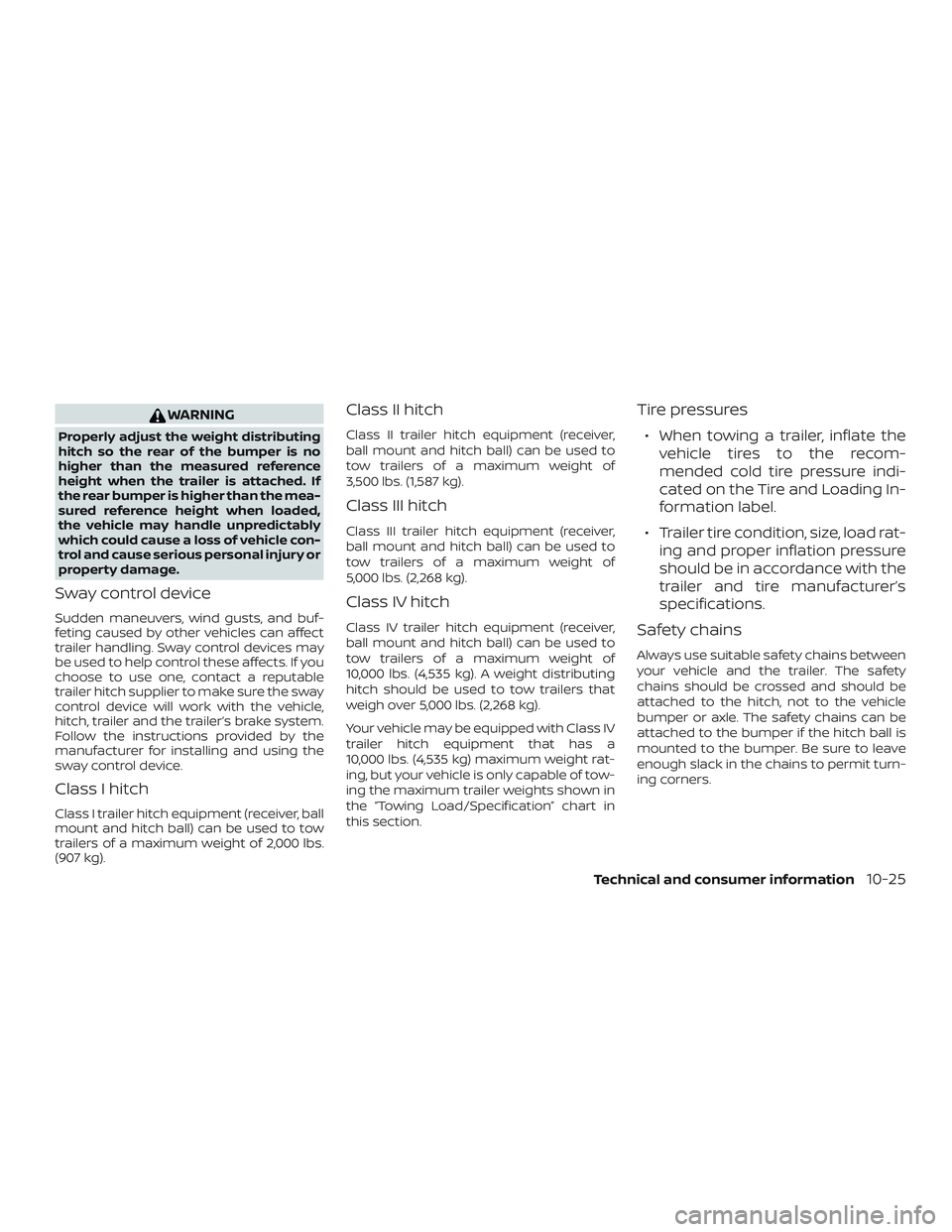
WARNING
Properly adjust the weight distributing
hitch so the rear of the bumper is no
higher than the measured reference
height when the trailer is attached. If
the rear bumper is higher than the mea-
sured reference height when loaded,
the vehicle may handle unpredictably
which could cause a loss of vehicle con-
trol and cause serious personal injury or
property damage.
Sway control device
Sudden maneuvers, wind gusts, and buf-
feting caused by other vehicles can affect
trailer handling. Sway control devices may
be used to help control these affects. If you
choose to use one, contact a reputable
trailer hitch supplier to make sure the sway
control device will work with the vehicle,
hitch, trailer and the trailer’s brake system.
Follow the instructions provided by the
manufacturer for installing and using the
sway control device.
Class I hitch
Class I trailer hitch equipment (receiver, ball
mount and hitch ball) can be used to tow
trailers of a maximum weight of 2,000 lbs.
(907 kg).
Class II hitch
Class II trailer hitch equipment (receiver,
ball mount and hitch ball) can be used to
tow trailers of a maximum weight of
3,500 lbs. (1,587 kg).
Class III hitch
Class III trailer hitch equipment (receiver,
ball mount and hitch ball) can be used to
tow trailers of a maximum weight of
5,000 lbs. (2,268 kg).
Class IV hitch
Class IV trailer hitch equipment (receiver,
ball mount and hitch ball) can be used to
tow trailers of a maximum weight of
10,000 lbs. (4,535 kg). A weight distributing
hitch should be used to tow trailers that
weigh over 5,000 lbs. (2,268 kg).
Your vehicle may be equipped with Class IV
trailer hitch equipment that has a
10,000 lbs. (4,535 kg) maximum weight rat-
ing, but your vehicle is only capable of tow-
ing the maximum trailer weights shown in
the “Towing Load/Specification” chart in
this section.
Tire pressures
∙ When towing a trailer, inflate thevehicle tires to the recom-
mended cold tire pressure indi-
cated on the Tire and Loading In-
formation label.
∙ Trailer tire condition, size, load rat- ing and proper inflation pressure
should be in accordance with the
trailer and tire manufacturer’s
specifications.
Safety chains
Always use suitable safety chains between
your vehicle and the trailer. The safety
chains should be crossed and should be
attached to the hitch, not to the vehicle
bumper or axle. The safety chains can be
attached to the bumper if the hitch ball is
mounted to the bumper. Be sure to leave
enough slack in the chains to permit turn-
ing corners.
Technical and consumer information10-25
Page 412 of 426
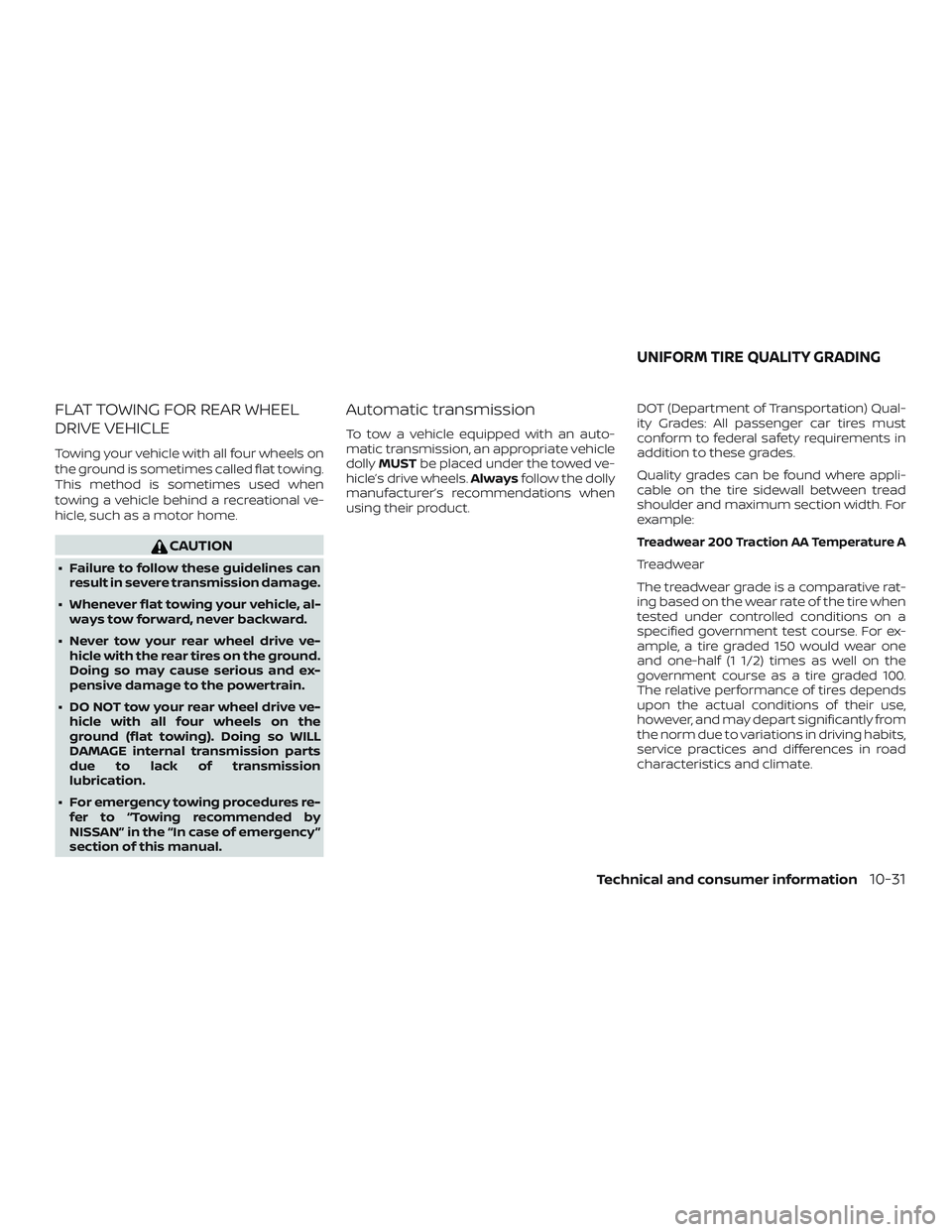
FLAT TOWING FOR REAR WHEEL
DRIVE VEHICLE
Towing your vehicle with all four wheels on
the ground is sometimes called flat towing.
This method is sometimes used when
towing a vehicle behind a recreational ve-
hicle, such as a motor home.
CAUTION
∙ Failure to follow these guidelines canresult in severe transmission damage.
∙ Whenever flat towing your vehicle, al- ways tow forward, never backward.
∙ Never tow your rear wheel drive ve- hicle with the rear tires on the ground.
Doing so may cause serious and ex-
pensive damage to the powertrain.
∙ DO NOT tow your rear wheel drive ve- hicle with all four wheels on the
ground (flat towing). Doing so WILL
DAMAGE internal transmission parts
due to lack of transmission
lubrication.
∙ For emergency towing procedures re- fer to “Towing recommended by
NISSAN” in the “In case of emergency ”
section of this manual.
Automatic transmission
To tow a vehicle equipped with an auto-
matic transmission, an appropriate vehicle
dolly MUST be placed under the towed ve-
hicle’s drive wheels. Alwaysfollow the dolly
manufacturer’s recommendations when
using their product. DOT (Department of Transportation) Qual-
ity Grades: All passenger car tires must
conform to federal safety requirements in
addition to these grades.
Quality grades can be found where appli-
cable on the tire sidewall between tread
shoulder and maximum section width. For
example:
Treadwear 200 Traction AA Temperature A
Treadwear
The treadwear grade is a comparative rat-
ing based on the wear rate of the tire when
tested under controlled conditions on a
specified government test course. For ex-
ample, a tire graded 150 would wear one
and one-half (1 1/2) times as well on the
government course as a tire graded 100.
The relative performance of tires depends
upon the actual conditions of their use,
however, and may depart significantly from
the norm due to variations in driving habits,
service practices and differences in road
characteristics and climate.
UNIFORM TIRE QUALITY GRADING
Technical and consumer information10-31
Page 413 of 426
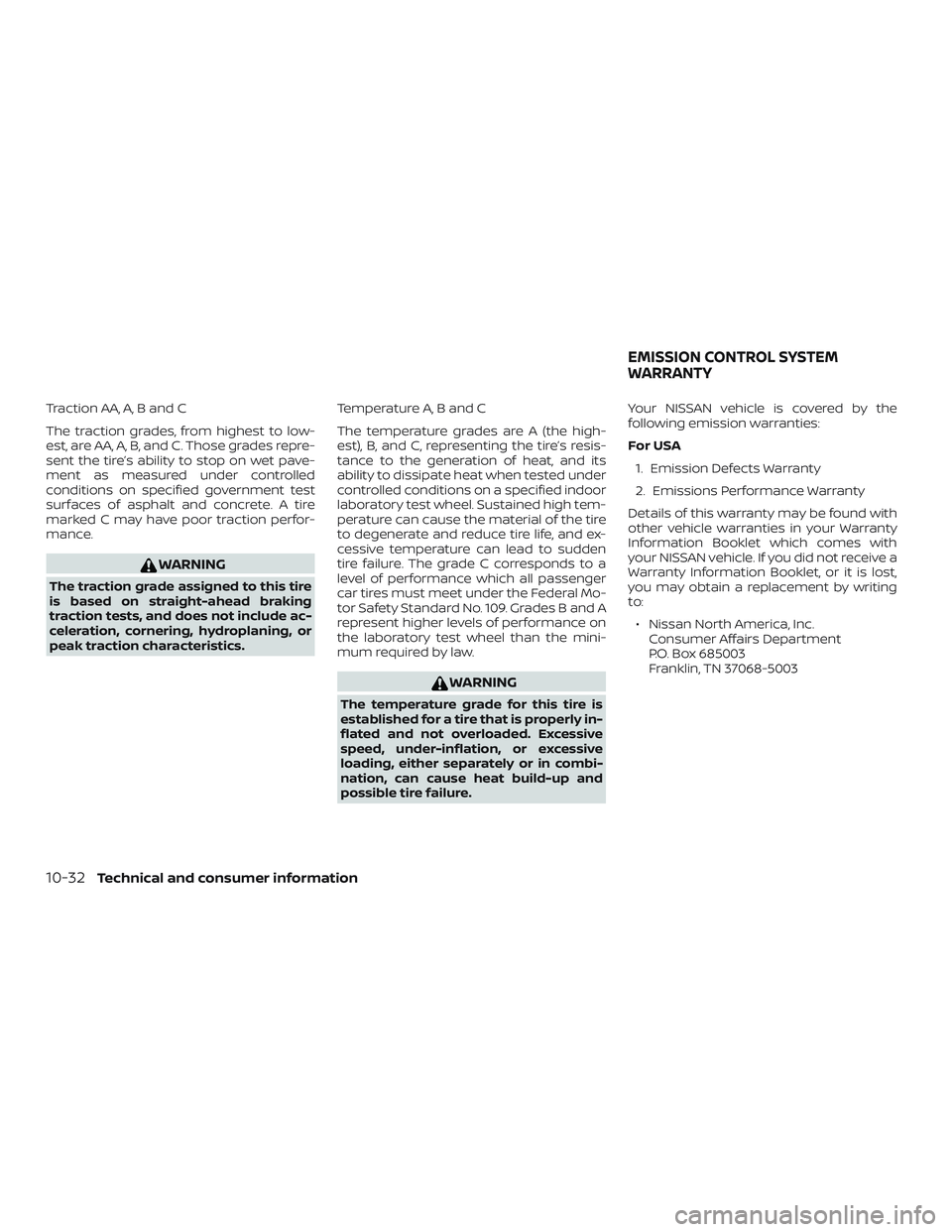
Traction AA, A, B and C
The traction grades, from highest to low-
est, are AA, A, B, and C. Those grades repre-
sent the tire’s ability to stop on wet pave-
ment as measured under controlled
conditions on specified government test
surfaces of asphalt and concrete. A tire
marked C may have poor traction perfor-
mance.
WARNING
The traction grade assigned to this tire
is based on straight-ahead braking
traction tests, and does not include ac-
celeration, cornering, hydroplaning, or
peak traction characteristics.Temperature A, B and C
The temperature grades are A (the high-
est), B, and C, representing the tire’s resis-
tance to the generation of heat, and its
ability to dissipate heat when tested under
controlled conditions on a specified indoor
laboratory test wheel. Sustained high tem-
perature can cause the material of the tire
to degenerate and reduce tire life, and ex-
cessive temperature can lead to sudden
tire failure. The grade C corresponds to a
level of performance which all passenger
car tires must meet under the Federal Mo-
tor Safety Standard No. 109. Grades B and A
represent higher levels of performance on
the laboratory test wheel than the mini-
mum required by law.
WARNING
The temperature grade for this tire is
established for a tire that is properly in-
flated and not overloaded. Excessive
speed, under-inflation, or excessive
loading, either separately or in combi-
nation, can cause heat build-up and
possible tire failure.Your NISSAN vehicle is covered by the
following emission warranties:
For USA
1. Emission Defects Warranty
2. Emissions Performance Warranty
Details of this warranty may be found with
other vehicle warranties in your Warranty
Information Booklet which comes with
your NISSAN vehicle. If you did not receive a
Warranty Information Booklet, or it is lost,
you may obtain a replacement by writing
to: ∙ Nissan North America, Inc. Consumer Affairs Department
P.O. Box 685003
Franklin, TN 37068-5003
EMISSION CONTROL SYSTEM
WARRANTY
10-32Technical and consumer information
Page 423 of 426
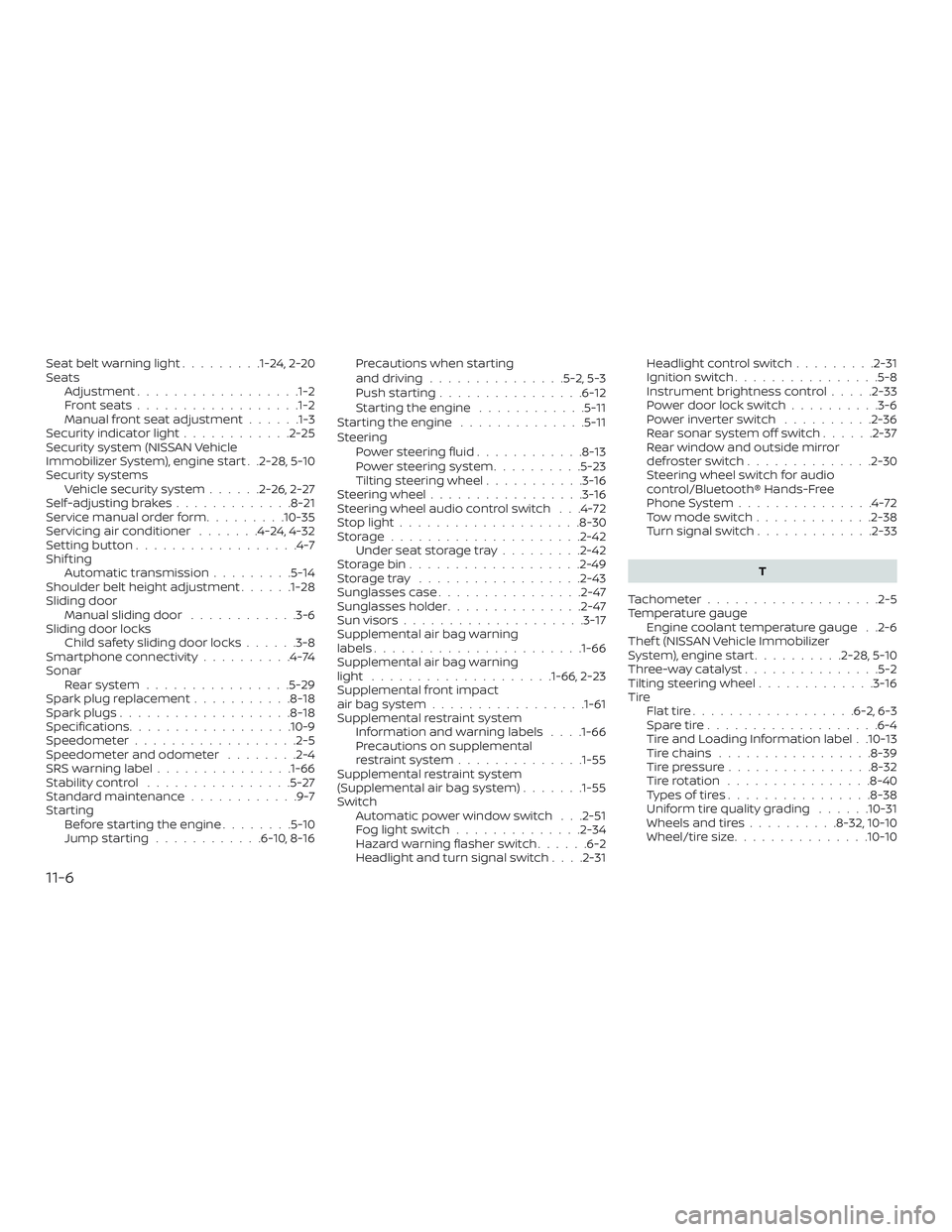
Seatbeltwarninglight.........1-24, 2-20
SeatsAdjustment ..................1-2
Frontseats..................1-2
Manual front seat adjustment ......1-3
Security indicator light ............2-25
Security system (NISSAN Vehicle
Immobilizer System), engine start . .2-28, 5-10
Security systems Vehicle security system ......2-26,2-27
Self-adjustingbrakes.............8-21
Service manual order form .........10-35
Servicing air conditioner .......4-24,4-32
Settingbutton..................4-7
Shif ting Automatic transmission .........5-14
Shoulder belt height adjustment ......1-28
Sliding door Manual sliding door ............3-6
Sliding door locks Child safety sliding door locks ......3-8
Smartphone connectivity ..........4-74
Sonar Rear system ................5-29
Spark plug replacement ...........8-18
Spark plugs ...................8-18
Specifications ..................10-9
Speedometer ..................2-5
Speedometer and odometer ........2-4
SRS warning label ...............1-66
Stability control ................5-27
Standard maintenance ............9-7
Starting Before starting the engine ........5-10
Jumpstarting............6-10,8-16 Precautions when starting
anddriving...............5-2,5-3
Push starting
................6-12
Starting the engine ............5-11
Starting the engine ..............5-11
Steering Powersteeringfluid............8-13
Powersteeringsystem..........5-23
Tilting steering wheel ...........3-16
Steering wheel .................3-16
Steering wheel audio control switch . . .4-72
Stoplight....................8-30
Storage.....................2-42 Under seat storage tray .........2-42
Storagebin...................2-49
Storagetray ..................2-43
Sunglasses case ................2-47
Sunglasses holder ...............2-47
Sunvisors....................3-17
Supplemental air bag warning
labels ...................... .1-66
Supplemental air bag warning
light ................... .1-66, 2-23
Supplemental front impact
airbagsystem................ .1-61
Supplemental restraint system Information and warning labels . . . .1-66
Precautions on supplemental
restraintsystem..............1-55
Supplemental restraint system
(Supplemental air bag system) .......1-55
Switch Automatic power window switch . . .2-51
Foglightswitch..............2-34
Hazard warning flasher switch ......6-2
Headlight and turn signal switch ....2-31Headlightcontrolswitch.........2-31
Ignition switch
................5-8
Instrument brightness control .....
2-33
Power door lock switch ..........3-6
Powerinverterswitch ..........2-36
Rear sonar system off switch ......2-37
Rear window and outside mirror
defrosterswitch..............2-30
Steering wheel switch for audio
control/Bluetooth® Hands-Free
Phone System ...............4-72
Tow mode switch .............2-38
Turn signal switch .............2-33
T
Tachometer ...................2-5
Temperature gauge Engine coolant temperature gauge . .2-6
Thef t (NISSAN Vehicle Immobilizer
System), engine start ..........2-28,5-10
Three-waycatalyst...............5-2
Tilting steering wheel .............3-16
Tire Flattire..................6-2,6-3
Spare tire ...................6-4
Tire and Loading Information label . .10-13
Tire chains .................8-39
Tire pressure ................8-32
Tirerotation ................8-40
Types of tires ................8-38
Uniform tire quality grading ......10-31
Wheels and tires ..........8-32,10-10
Wheel/tire size ...............10-10
11-6